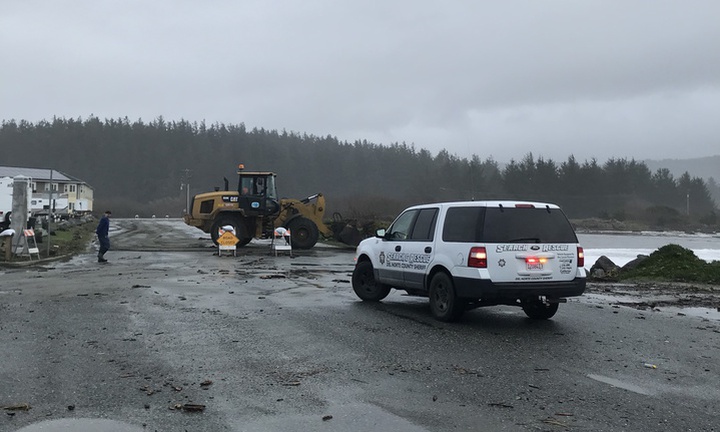Jessica Cejnar Andrews / Tuesday, April 30, 2024 @ 2:11 p.m.
Del Norte Transportation Official Says Public Input is Needed In Efforts To Shore Up South Beach Area Against Climate Change

Del Norte County Search & Rescue are on standby in this Jan. 5, 2023 photo as crews remove debris from Anchor Way following a winter storm. | Photo courtesy of Garrett Scott
The Del Norte Local Transportation Commission’s executive director wants to get as much public input as possible on a plan to shore up U.S. 101 and Anchor Way against climate change.
The South Beach Climate Resilience Plan wouldn’t address sea level rise since that isn’t a problem in Del Norte County, Tamera Leighton said Tuesday. Instead it’s the more intense rain, storm surge and debris that washes onto the road from both sides as a result of climate change, she said.
“It’s projected we will have more intense storms, more rain all at once and those intense storms are part of what causes problems on South Beach,” Leighton told the Wild Rivers Outpost. “It’s in the Crescent City Marsh area and it’s the ocean washing over the road.”
Leighton, Elk Valley Rancheria Chief Operations Officer Crista Stewart and Brandon Larson, deputy director of planning for Caltrans District 1, drew attention to the South Beach Climate Resilience Plan at the Crescent City-Del Norte County Chamber of Commerce’s economic summit on Friday.
Leighton urged attendees to complete a survey, noting that when storm surge shuts U.S. 101 down, those motorhomes and cars get diverted through Elk Valley Rancheria. The plan not only includes the highway alongside South Beach, but Anchor Way to the boat launch at the Crescent City Harbor.
“What happens is all of that local traffic traveling down U.S. 101 goes on our local roadway system,” Leighton said. “Now we have another safety problem. [Caltrans], they’re the owners and operators of the state highway system, but what happens when it is closed? All that traffic then becomes our problem.”
The Local Transportation Commission partnered with Elk Valley Rancheria and the Crescent City Harbor District to obtain a $268,207 Climate Adaptation Planning Grant from Caltrans. The DNLTC is also using $34,749 in state dollars as its contribution to the overall planning project cost, which is $302,956, according to Leighton.
According to the DNLTC’s Climate Adaptation Grant application, an average of 6,100 cars per day travel along U.S. 101 and Google Maps and other GPS wayfinding apps divert traffic to Elk Valley Road when storms force local officials to close the highway.
In 2017, the intersection at Elk Valley Road and Howland Hill Road was 265 percent above the statewide average for the total number of crashes and 49 percent above the statewide average for injury and fatal crashes, according to the DNTLC’s grant application.
In 2017, peak hourly volume at Howland Hill and Elk Valley was 474.
“When 6,100 vehicles per day are added to the current conditions, the road will become exponentially unsafe for all,” Leighton wrote in the application. “”Elk Valley Road has narrow lanes, steep hills, blind curves and no shoulders in the direction that all through traffic will be sent.”
Traffic detoured from U.S. 101 also impacts Elk Valley Rancheria tribal members, especially due to the increase in semis. Impacted services include Elk Valley Head Start, the tribal cemetery, off-reservation trust land and Elk Valley Casino. About 220 employees and patrons use Elk Valley Road, according to Leighton’s grant application.
“Although the tribe completed a safety project on a portion of Humboldt Road, which added sidewalks and streetlights at the intersection of Sandmine Road, there are no sidewalks,” she said. “This creates additional hazards for pedestrians and bicycles utilizing this section during these high traffic periods.”
In addition to the Climate Adaptation Planning Grant, the Elk Valley Rancheria is pursuing a California Coastal Conservancy grant to improve underperforming culverts along U.S. 101 through South Beach.
According to Stewart, the Rancheria will partner with Caltrans, the DNLTC and Harbor District along with the California Department of Fish and Wildlife to determine what the flows are like from the Crescent City Marsh.
“We will be holding a great deal of public meetings,” Stewart said. “We’re hoping that everyone will take part in these meetings to ensure that the public is aware of what our plans are and to get your feedback. We know this is such an important part of what Crescent City is.”
Though she’s not yet sure what solutions the resilience plan will come up with, Leighton said there will be solutions. One could be a causeway, she said.
“Just let the Crescent City Marsh be and let the beach be,” she said. “There’s all kinds of ideas about potential solutions. That’s just one of whatever’s going to come up in this process.”
CLICK TO MANAGE